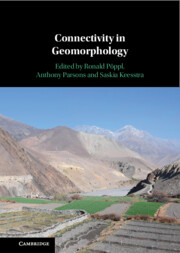Book contents
- Connectivity in Geomorphology
- Connectivity in Geomorphology
- Copyright page
- Contents
- Contributors
- Preface
- Acknowledgements
- Part I Introduction
- Part II Connectivity in Process Domains
- 3 Hillslope Processes
- 4 Fluvial Processes
- 5 Aeolian Processes
- 6 Glacial Processes
- 7 Periglacial Processes
- 8 Coastal and Deltaic Environments
- Part III Quantifying Connectivity in Geomorphology
- Part IV Managing Connectivity
- Index
- References
4 - Fluvial Processes
from Part II - Connectivity in Process Domains
Published online by Cambridge University Press: 10 April 2025
- Connectivity in Geomorphology
- Connectivity in Geomorphology
- Copyright page
- Contents
- Contributors
- Preface
- Acknowledgements
- Part I Introduction
- Part II Connectivity in Process Domains
- 3 Hillslope Processes
- 4 Fluvial Processes
- 5 Aeolian Processes
- 6 Glacial Processes
- 7 Periglacial Processes
- 8 Coastal and Deltaic Environments
- Part III Quantifying Connectivity in Geomorphology
- Part IV Managing Connectivity
- Index
- References
Summary
This chapter discusses what is meant by connectivity in fluvial systems and how the connectivity approach differs from preceding research, the way in which it increases understanding of fluvial processes, and how knowledge of mechanisms and dynamics of processes fits into this framework. The focus is on longitudinal connectivity through river systems, mainly in large catchments and river channels and much of the attention is on sediment connectivity. The application of connectivity indices and graph theory are exemplified and the patterns, distributions and controls produced by connectivity analysis are demonstrated. Lateral connectivity is important in relation to the link of channels to floodplains and in maintaining functioning of wetlands. Recent developments of techniques and models have allowed additional factors to be incorporated and controls on connectivity of fluvial processes to be identified. The use of connectivity analysis as a framework is highly beneficial in management of fluvial systems and facilitates targeting of hotspots of sediment accumulation or depletion.
Keywords
- Type
- Chapter
- Information
- Connectivity in Geomorphology , pp. 48 - 79Publisher: Cambridge University PressPrint publication year: 2025

